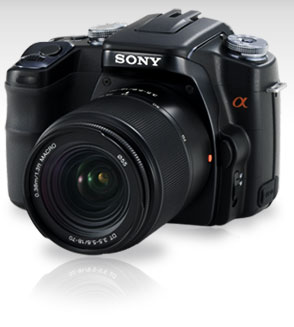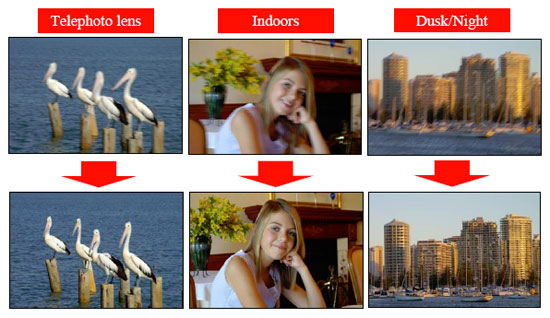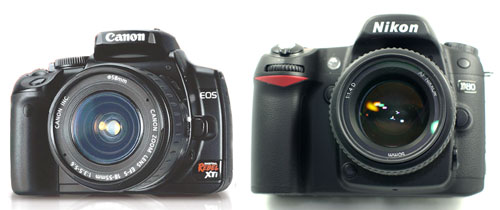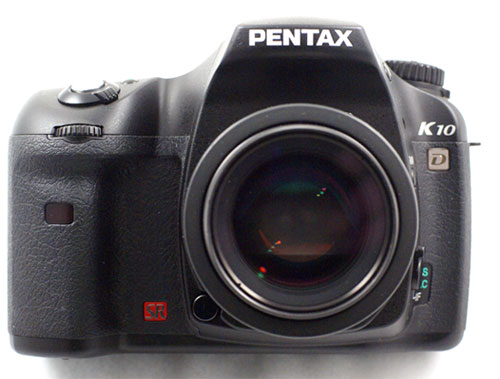10 Megapixel SLRs

The Sony A100 pioneered the 10 megapixel market when it was introduced this past summer. Sony acquired Minolta and based the new A100 on the entry level Minolta Maxxum 5D.

Sony continued the then-unique in-camera image stabilization pioneered by Minolta, which allowed any lens mounted on the camera to take sharper pictures at slower shutter speeds. Olympus had pioneered a popular feature that placed the sensor behind an antistatic protector, and that shook any stray dust off the sensor when the camera was turned on or shut down. Sony added a similar feature to their revision of the Maxxum digital SLR.
Sony inherited and continued the Minolta Maxxum autofocus lens mount, which meant almost any Minolta Maxxum lens ever made would work perfectly on the new Sony SLR camera. The A100 shocked the digital SLR market, since it brought the 10 megapixel resolution to market at a 6 megapixel price. This was also reflected in the selection of the Sony A100 as "Camera of the Year 2006" by the largest photo specialty magazine.

Canon and Nikon dominate the serious photography market, so it was no surprise that both followed in Sony's footsteps a couple of months later with their own 10 megapixel models. The Nikon D80 borrowed the processing engine, fast focusing module, and 10 megapixel sensor from their successful but expensive D200 model. All of the current 10 megapixel SLR cameras - except Canon - are based on the Sony 10 megapixel sensor. Nikon would point out, however, that the sensor interface and image processing "hardware" are their own design, and that the interface and processing account for much of how the sensor actually performs.
Canon basically increased the resolution of their CMOS sensor used in the 8 megapixel Rebel XT to 10 megapixels, and dubbed the revised camera the Canon Rebel XTi. They did incorporate the improved image processing guts of their semi-PRO 30D and finally added their own dust removal system - much like the one pioneered by Olympus. Canon also added dust removal capabilities to their bundled image-editing software.

The latest 10 megapixel SLR is the long-awaited Pentax K10D. Pentax took longest to get their 10 megapixel Sony sensor model to market, but the time certainly was not wasted. In many ways the Pentax is the most professional and full-featured of the 10 megapixel choices, since it incorporates special sealing for dust and moisture protection, similar to the sealing of the top professional SLR models. Pentax also refined the "in-camera" anti-shake pioneered by Minolta/Sony by adding permanent magnets in both horizontal and vertical planes. This allows rotation in the diagonal as well as horizontal/vertical planes and is claimed to extend low-light shooting up to four full f-stops.
Pentax also brought over their innovative hyper-program feature from top Pentax cameras of the past. This allows users to keep the camera on program and adjust either aperture or shutter speed to what they want in a shot. The program compensates by adjusting the other program variables automatically. Pentax added "ISO Priority" to the typical SLR offerings of full program (green zone), program, aperture-priority, shutter-priority, and full manual. This seemed a natural extension of one of the Digital SLR's best features - built-in film (Sensor) with very wide sensitivity (ISO). To top it off Pentax made sure the new K10D, and lower-priced K100D and K110D, would be fully compatible with any K-mount lens ever produced, including excellent "focus-assist" features for non AF lenses and the ability to manually dial in info from very old lenses that can still benefit from Pentax lens stabilization.
These four cameras are loaded with features and represent the current crop of 10 megapixel offerings. Samsung has also announced they will be marketing a 10 megapixel model just after the holidays which is to be called the Samsung GX-10. The new Samsung model is basically a relabeled Pentax with the same feature set.

The Sony A100 pioneered the 10 megapixel market when it was introduced this past summer. Sony acquired Minolta and based the new A100 on the entry level Minolta Maxxum 5D.

Sony continued the then-unique in-camera image stabilization pioneered by Minolta, which allowed any lens mounted on the camera to take sharper pictures at slower shutter speeds. Olympus had pioneered a popular feature that placed the sensor behind an antistatic protector, and that shook any stray dust off the sensor when the camera was turned on or shut down. Sony added a similar feature to their revision of the Maxxum digital SLR.
Sony inherited and continued the Minolta Maxxum autofocus lens mount, which meant almost any Minolta Maxxum lens ever made would work perfectly on the new Sony SLR camera. The A100 shocked the digital SLR market, since it brought the 10 megapixel resolution to market at a 6 megapixel price. This was also reflected in the selection of the Sony A100 as "Camera of the Year 2006" by the largest photo specialty magazine.

Canon and Nikon dominate the serious photography market, so it was no surprise that both followed in Sony's footsteps a couple of months later with their own 10 megapixel models. The Nikon D80 borrowed the processing engine, fast focusing module, and 10 megapixel sensor from their successful but expensive D200 model. All of the current 10 megapixel SLR cameras - except Canon - are based on the Sony 10 megapixel sensor. Nikon would point out, however, that the sensor interface and image processing "hardware" are their own design, and that the interface and processing account for much of how the sensor actually performs.
Canon basically increased the resolution of their CMOS sensor used in the 8 megapixel Rebel XT to 10 megapixels, and dubbed the revised camera the Canon Rebel XTi. They did incorporate the improved image processing guts of their semi-PRO 30D and finally added their own dust removal system - much like the one pioneered by Olympus. Canon also added dust removal capabilities to their bundled image-editing software.

The latest 10 megapixel SLR is the long-awaited Pentax K10D. Pentax took longest to get their 10 megapixel Sony sensor model to market, but the time certainly was not wasted. In many ways the Pentax is the most professional and full-featured of the 10 megapixel choices, since it incorporates special sealing for dust and moisture protection, similar to the sealing of the top professional SLR models. Pentax also refined the "in-camera" anti-shake pioneered by Minolta/Sony by adding permanent magnets in both horizontal and vertical planes. This allows rotation in the diagonal as well as horizontal/vertical planes and is claimed to extend low-light shooting up to four full f-stops.
Pentax also brought over their innovative hyper-program feature from top Pentax cameras of the past. This allows users to keep the camera on program and adjust either aperture or shutter speed to what they want in a shot. The program compensates by adjusting the other program variables automatically. Pentax added "ISO Priority" to the typical SLR offerings of full program (green zone), program, aperture-priority, shutter-priority, and full manual. This seemed a natural extension of one of the Digital SLR's best features - built-in film (Sensor) with very wide sensitivity (ISO). To top it off Pentax made sure the new K10D, and lower-priced K100D and K110D, would be fully compatible with any K-mount lens ever produced, including excellent "focus-assist" features for non AF lenses and the ability to manually dial in info from very old lenses that can still benefit from Pentax lens stabilization.
These four cameras are loaded with features and represent the current crop of 10 megapixel offerings. Samsung has also announced they will be marketing a 10 megapixel model just after the holidays which is to be called the Samsung GX-10. The new Samsung model is basically a relabeled Pentax with the same feature set.










89 Comments
View All Comments
Wesley Fink - Wednesday, December 27, 2006 - link
To be clear the Sony A100 was the Best Buy or the best price among the 10 megapixel models. The Pentax K10D was named Best Value, as the most 10 mepapixel camera for the money. We stand by both those recommendations.spazmedia - Thursday, December 28, 2006 - link
Didn't Minolta get sued for steeling the auto focus idea from Honeywell? ;-)And do all Minolta lenses have focusing motors in the lens? Are they silent when focusing? There are lots of lenses available for Nikon and/or Canon that are not available elsewhere. To each his own.
gibhunter - Wednesday, December 27, 2006 - link
That's just one of the FUD Canon's owners are spreading. Canon is definitely faster, but only accuracy helps you get sharper pictures. It is pretty well known that Canon sacrifices a bit of accuracy for outright speed. Canon is the fastest focusing body and it can mean the difference between taking a shot of a great moment or have it pass you by while you're waiting for the camera to focus, but that's all it is. That's why Canon is so popular with pros shooting sports. I'd venture to say that as long as we're talking about accuracy no system is quantitatively better than another.
Now on topic of optical vs. body based stabilization. It has not been proven either way that one system is better than another. It's been proven that body based system is kind of limited at 1.2 meters (the length tested at dpreview). I have not seen any tests where one system was compared against another, but I have seen examples of 300mm at 1/30th tack sharp on Pentax forums and have taken sharp images hand-held at 1/10th and consistently sharp at 1/20th with my K100D. Optical stabilization is not available on any Canon or Nikon primes. It's not really needed until you get into low light photography where even the fastest primes need to go down to 1/20th or 1/30th of a second. Then you will appreciate having it.
Optical is better at one thing though, it allows for vertical stabilization while you're paning (following a moving object so it's sharp while the background is blurry). Pentax stabilization system can't do it. What it can though is give you stabilization on all your lenses, even 30 year old 50mm primes. I know it can because I've tested it myself using two different manual primes.
What can't be disputed is Canon's lens availability. You can find more lenses at lower prices and you can find great, expensive pro-level quality lenses on the Canon. You can also get USM primes (something not yet available for Nikon unless you consider Sigma.) Canon's bodies leave a lot to be desired as far as control and innovation go, unless you get into $3000+ territory of 5D. 30D pales in features compared to Nikon D200 or Pentax K10D. Then again those features are just a matter of convenience as you can take equally beautiful images with all these cams.
spazmedia - Wednesday, December 27, 2006 - link
I find it strange that you do not see any pics produced by each camera. Essentially all that the author is doing is comparing specs of camera, which to add insult to injury this is done erroneously. On page 2 the Canon XTI was one GREAT advantage not mentioned is the improved autofocus engine, borrowed from the 30D, which according to many reviewers is better than any camera mentioned in this review, and definitely better than the K10D. It helps to get sharp pictures!In any case I advise anyone visiting this site to go to some more thorough review sites on photography to SEE what kind of pictures each camera takes and also try in store each one of them. You can’t go wrong with any of them, except that Canon arguably has the best lens lineup for the price and low noise, Nikon have to arguably the most useable cameras, Pentax and Sony have the best bang for the buck, body wise (but not when it comes to lenses, which are more expensive and low availability) Anandtech is good for computer hardware reviews, but for photography, they still have some work to do!
Wesley Fink - Wednesday, December 27, 2006 - link
This is a Buying Guide and not a full-blown review. The viewfinder images were mostly shot with the camera they are identified with.We welcome criticism at AT, unlike some other sites. However, it is frustrating to be criticized for inaccuracy in leaving out info when that info is in the review. On p.1 "All of the 10 megapixel SLRs are faster than their predecessors - borrowing processing engines from higher priced models (Nikon and Canon) or pioneering new high-speed processing circuits (Pentax and Sony)." Then in the Canon XTi section on p.2 "Canon basically increased the resolution of their CMOS sensor used in the 8 megapixel Rebel XT to 10 megapixels, and dubbed the revised camera the Canon Rebel XTi. They did incorporate the improved image processing guts of their semi-PRO 30D and finally added their own dust removal system . . ." Perhaps you should read more closely.
spazmedia - Thursday, December 28, 2006 - link
Thanks for the reply. I did read through "fairly" closely and I still don't understand how you can associate "image processing" with auto-focus, to me these are two different things. I think it would be worth mentioning clearly that the Rebel XTI focuses faster and more accurately than its predecessor, seeing it is top of its class in this respect. This is probably the single biggest reason for upgrading from the previous Rebels and I way I hate Canon for dolling out features.And I still think a few images from each camera would have been nice.
AT is usually very thorough and I would have expected this in their camera reviews/buyers guide as well. Maybe some sort of table comparing features would have been useful.
finbarqs - Wednesday, December 27, 2006 - link
i've taken one photography class in black and white, and that opened up a whole world of photography for me and the wonders of the camera. I mean both Pentax and Canon and Nikon all pioneered something in their field, and i'm sure they have their strong points and their weaknesses. The truth is, the weakness being digital, and having the dynamic range of film is quite difficult to obtain. Sure we can use Neutral Grey Density filters, but still not quite the right thing. Then we can setup a tripod and do the "Dynamic Range" in photoshop but that's just up to the person.Personally, I wish i had enough to purchase the Canon 5D just so i can have their full frame image sensor. I hear it's the closest you can get to the reaction of lighton the film emulsion surface vs. film on the sensor surface. I may be wrong again since this is my first class, but then again, i've learned a lot from this class. Besides, I've taken awesome shots with the XTi, and i know for a fact that changing different cameras will only improve it by a little bit.
*sigh* might as well go back to film :D
Justin Case - Wednesday, December 27, 2006 - link
The bigger sensor on the 5D (and 1Ds) gives you shallower depth of field, which increases your "artistic" control over the image. Also, the fact that the sensor is physically bigger means it can receive more light, and therefore produce an image with less noise. But the size won't really influence the dynamic range of the sensor.With film, you can sometimes get some detail in an area that was overexposed by 3 or 4 f-stops. With digital, that range is about 2 stops, if you're lucky (and shoot in raw mode, of course).
So yes, in that sense, digital still can't quite match film, but it already has less noise and more detail, so, for correctly exposed images, it already beats (35mm) film, even with smaller sensors. If you need a higher range, then you can use exposure bracketing but, of course, that isn't always possible, so film still has its place.
finbarqs - Thursday, December 28, 2006 - link
umm... from what i've learned, Depth of Field is determined by the setting of the apeture (F-stop) the lower the F-Stop (bigger apeture) the less DOF you have. Of course, again the benefit of the 5D and the 1D is not the Depth of Field, but having all lenses "normal". Meaning, a normal lens would be 42-55mm again, standard wide angle is 28mm, and standard telephoto portrait would be 135mm (of course anything above normal would be tele, anything below normal would be wide). And to get more detail, usually we just stop down as much as we can (since 35mm is usually limited to f/22 or f/32 -- most i've seen unless shooting with medium format or greater). Oh well... Detail lies within the size of the film as i have learned, and as far as digital goes, both size and quality of the sensor. The CMOS chip, is quite impressive.Justin Case - Friday, December 29, 2006 - link
> from what i've learned, Depth of Field is> determined by the setting of the apeture (F-stop)
For the same sensor / film size, yes. But if the sensor size is different, that will also affect the DOF. A smaller sensor will give you a narrower FOV and a bigger DOF, using the same lens and same aperture. That is why it's virtually impossible to get nice out-of-focus backgrounds with small digicams - the sensor is too small.
For example, if you put a "100mm" lens on a 1.5x crop factor camera (like a Nikon D200), where the sensor isn't the same size as a 35mm frame, you'll actually get an image equivalent to a 150mm lens (on a real 35 mm camera), and also bigger DOF. Which is good for holiday snaps, not so good for "artistic" photography.
Also, most lenses are optimized for f/stops between f/4 and f/16 (f/8 and f/16 for cheap ones). If you close down more than that, quality actually starts to get a little worse at the focus point (you will increase the DOF, so you have more things in focus, but focus is never quite as sharp - it's a tradeoff).
"Detail" is a broad concept. More pixels doesn't necessarily mean more detail, because as you cram more pixels into the same sensor area, each one gets less light, and is therefore less accurate (i.e., you get more noise, and that can actually make a sensor with more pixels produce _less_ detail). A similar thing happens with film: more sensitive film will give you less detail, because it has more grain.